The White-Throated Kingfisher, also recognized as the White-Breasted Kingfisher captivates enthusiasts worldwide with its resplendent azure plumage and stark white throat.
This avian gem, prevalent throughout Asia, enchants observers with its striking appearance and intriguing behavior and dietary habits.
As an integral part of its ecosystem, the White-Throated Kingfisher serves as predator and prey, showcasing its significance in maintaining ecological balance.
However, understanding and addressing its conservation status is paramount amidst habitat degradation and human encroachment.
Delving into its current status unveils the challenges faced by this magnificent species and highlights the urgency for concerted conservation efforts.
Overview of White-Throated Kingfisher
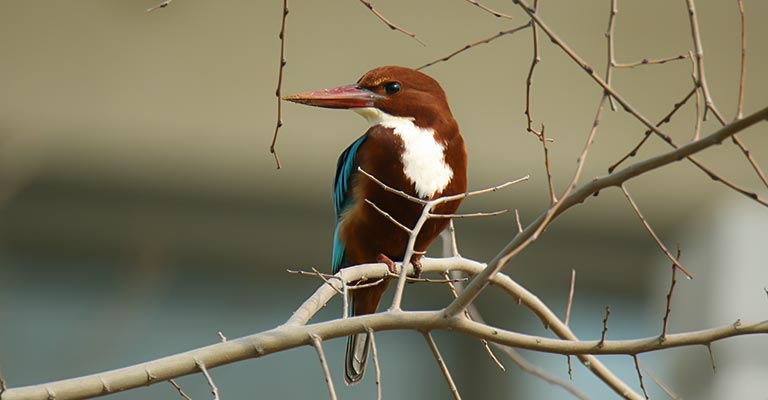
Occasionally, you’ll spot a White-Throated Kingfisher perched on a tree’s branch, projecting a vibrant palette of colors into the Asian skies.
Its vivid blue feathers and signature white throat are not the only traits that draw me – and countless others – to this ethereal bird. The bird’s unique behavior and diet left me curiously intrigued.
The White-Throated Kingfisher often prefers solitary or pair living conditions in the wild. Unlike many bird species, it’s not known to form flocks.
But don’t be fooled by their solitary nature; these birds are territorial. If another bird dares to venture into their designated space, they are not afraid to vocally and physically show their discontent.
Moreover, their diet isn’t as you might expect from a species with ‘Kingfisher’ in their name—many associate Kingfishers with a diet heavily reliant on fish. Yet, our White-Throated Kingfisher here offers an exciting twist.
Primarily insectivorous, the White-Throated Kingfisher readily feasts on various prey. Its culinary preferences include insects, amphibians, reptiles, and even small mammals.
Surprisingly, fish are only a tiny part of their diet. Their adept hunting skills and swift execution make them a top predator within their small ecosystem.
| Prey | Percentage in Diet |
|---|---|
| Insects | 50% |
| Amphibians | 20% |
| Reptiles | 15% |
| Small mammals | 10% |
| Fish | 5% |
Whether it’s their striking color palette or unconventional eating habits, the White-Throated Kingfisher never fails to captivate those lucky enough to observe them. The next part of our narrative will focus on the habitat preferences of these enigmatic birds.
Physical Characteristics
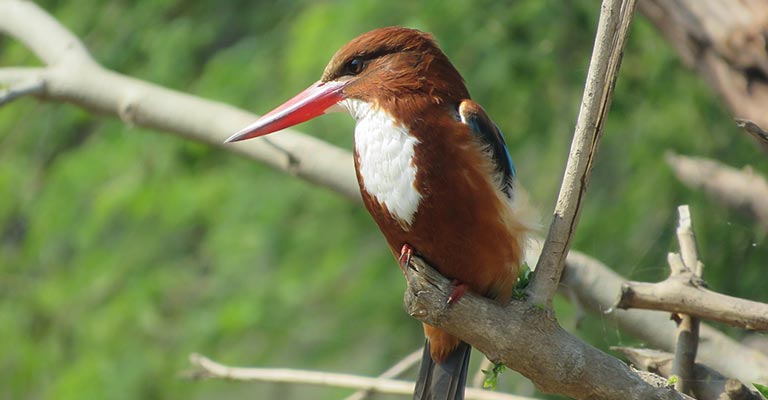
Just one glance at the White-Throated Kingfisher is all it takes to be captivated by this avian wonder. It is not only its robust build that’s striking but also the vibrant colors that command attention.
The wings and tail are a dazzling combination of bright blue and turquoise. It makes a vibrant contrast with the cinnamon-colored body and distinct white throat.
The White-Throated Kingfisher, averaging a size of 25 to 28 centimeters, holds an unmistakably brisk stance.
Its vivid beak, a solid and broad dagger-like apparatus, is an almost iridescent black-blue. This stellar feature is crucial for its varied diet habits – equally adept at catching creeping insects or swooping fish.
Its alert black eyes, surrounded by patches of blue, say a lot about its prey-spotting capabilities. Taking its name from the pristine white patch enveloping its throat and ‘breast,’ this kingfisher exhibits a visually pleasing ripple of colors down its abdomen. The males and females have a nearly similar palette with minimal discernible differences.
You might notice a unique characteristic of the White-Throated Kingfisher in its stout, darkly colored legs. These are not only used as supportive struts when it is perched high. They are also agile, dashing outwards to secure unsuspecting prey.
Let’s take a quick summary in the below table of the physical characteristics of the White-Throated Kingfisher:
| Feature | Description |
|---|---|
| Size | 25 – 28 cm |
| Beak | Iridescent black-blue, Dagger-like |
| Eyes | Black with blue patches |
| Body color | Cinnamon colored with Bright Blue and Turquoise wings |
| Legs | Stout, Darkly colored |
| Throat | White |
Habitat and Distribution
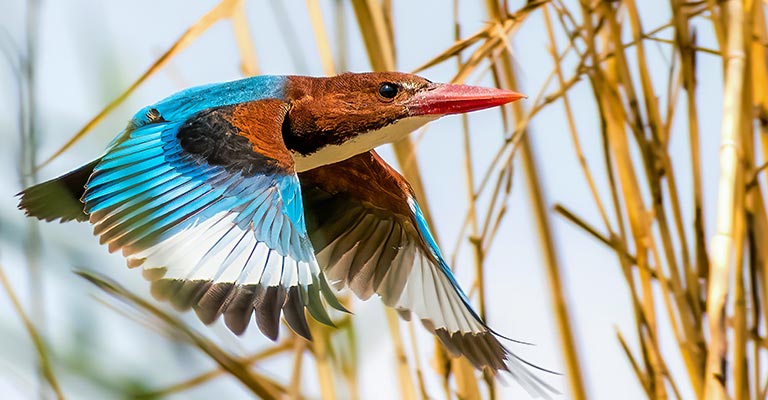
Dive into the world of this colorful avian creature, and you’ll find a bird that’s versatile and adaptable across different habitats.
The White-Throated Kingfisher isn’t too picky about where it nests. While its principal habitats are coastal areas, mangroves, and wetlands, it’s proficient in adapting to other environments like agricultural fields, gardens, and even urban areas!
This bird disregards traditional bird territory’s boundaries and astounds us with its resilience and adaptability.
To put this bird’s wide habitat range into perspective, let’s look closer at where these striking birds are usually spotted. Transparency is key here, so I’ll break down the distribution of the White-Throated Kingfisher.
| Location | Type of Area |
|---|---|
| Asia | Coastal areas, wetlands, mangroves |
| Middle East | Wetlands, agriculture fields |
| Europe | Gardens, urban areas |
This table reflects the bird’s cosmopolitan range. Wherever there are puddles, ponds, creeks, or small bodies of water, you’ll likely find this kingfisher.
From the dense tropical rainforests of Southeast Asia to the scrublands of the Middle East and urban backyards of Europe, the White-Throated Kingfisher has marked its presence.
Behavior and Diet
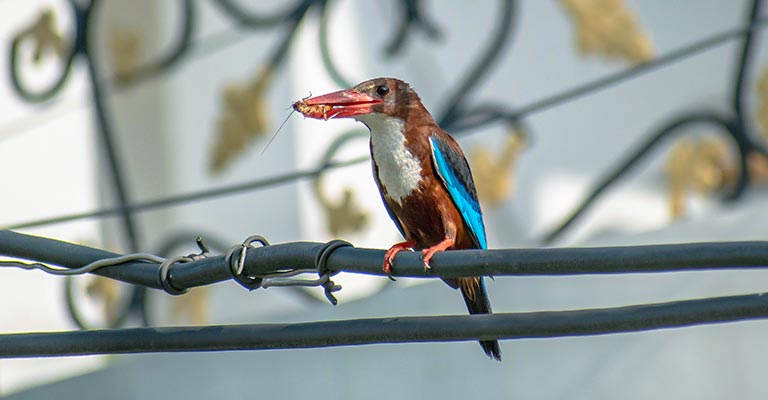
Representing yet another fascinating aspect of the White-Throated Kingfisher is its behavior. Its classic hunting technique is what I’d call a ‘watch and dive’ strategy.
This usually involves the bird perching quietly, observing the ground below for movement, and diving like a bullet to catch its prey.
Efficient hunting methods combine with a broad diet, enabling this kingfisher to thrive in varied environments.
Contrary to what the ‘Kingfisher’ moniker might suggest, fish aren’t the only items on this bird’s menu. The White-Throated Kingfisher boasts a diverse diet. It’s an opportunistic feeder that dines on many creatures ranging from insects, rodents, and small reptiles to even baby birds.
Let me share some stats that give a clearer picture:
| Prey | Frequency (%) |
|---|---|
| Insects | 65 |
| Small Reptiles | 18 |
| Rodents | 12 |
| Baby Birds/Small Birds | 5 |
It’s worth noting how these numbers fluctuate depending on the habitat, availability of prey, and time of year. It underscores the White-Throated Kingfisher’s adaptability and resilience.
For instance, they skewed more towards a diet of insects during monsoon seasons when they’re abundant and focused on fish or frogs around wetlands.
Moving on from its dietary habits, let me highlight another intriguing aspect of this bird’s behavior – its nesting practices.
The White-Throated Kingfisher isn’t a flock bird. It prefers solitude and can be quite territorial, especially during breeding season.
It’s known for digging tunnels into muddy banks or the sides of ditches to build its nest. Once the nest is complete, the bird lays around 3-7 eggs, which both parents incubate and look after.
To put it plainly, the White-Throated Kingfisher’s behavioral traits and diverse dietary habits are testaments to its remarkable adaptability. This level of flexibility allows it to live and prosper in various geographical locations and weather conditions.
Conservation Status
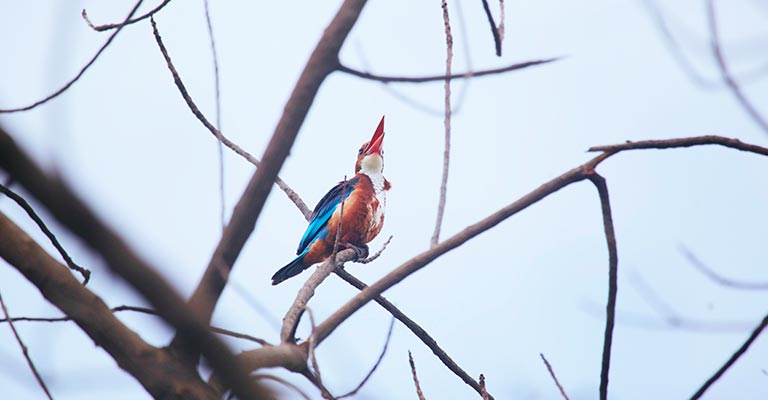
Shifting gears to discuss the White-Throated Kingfisher’s survival, we’ll dive into its conservation status.
The population dynamics of this kingfisher presents an interesting paradox. While it’s shared across its vast range, its numbers are commonly underestimated due to its ‘sit and wait’ hunting style. While the bird may be present in an area, it may go unnoticed, skewing population estimates.
Contrary to most birds, White-Throated Kingfisher’s populations are believed to be stable – neither increasing nor decreasing significantly.
Sure, habitat loss and human activities can affect their numbers, but these effects depend on the region and local circumstances.
A significant cause of concern is the loss and degradation of wetlands – the prime habitat of the White-Throated Kingfisher. Rapid urbanization, drainage for agriculture, and pollution are some factors leading to wetland habitat loss.
It’s important to remember, however, that the conservation status of the White-Throated Kingfisher is subject to change as new information comes to light. Therefore, ongoing research and monitoring of this species are crucial.
| IUCN Conservation Status | Population Trend |
|---|---|
| Least Concern | Stable |
By understanding and addressing these threats, we can continue to ensure the survival of this bold, brash bird that adds a splash of color to landscapes across its range.
Conclusion
The White-Throated Kingfisher’s vibrant colors and distinctive call make it a delight to spot. It’s a common sight across its range, yet its numbers are often underestimated due to its unique hunting style.
Even with a “Least Concern” status, it’s not immune to threats. Habitat loss, especially in wetlands, is a crucial challenge this bird faces. We mustn’t take this status for granted.
Ongoing research and consistent monitoring are essential to ensure the bird’s existence. So, next time you spot a White-Throated Kingfisher, remember there’s more to its story than meets the eye.
It’s a testament to nature’s adaptability and resilience, a colorful reminder of why we must strive for conservation.